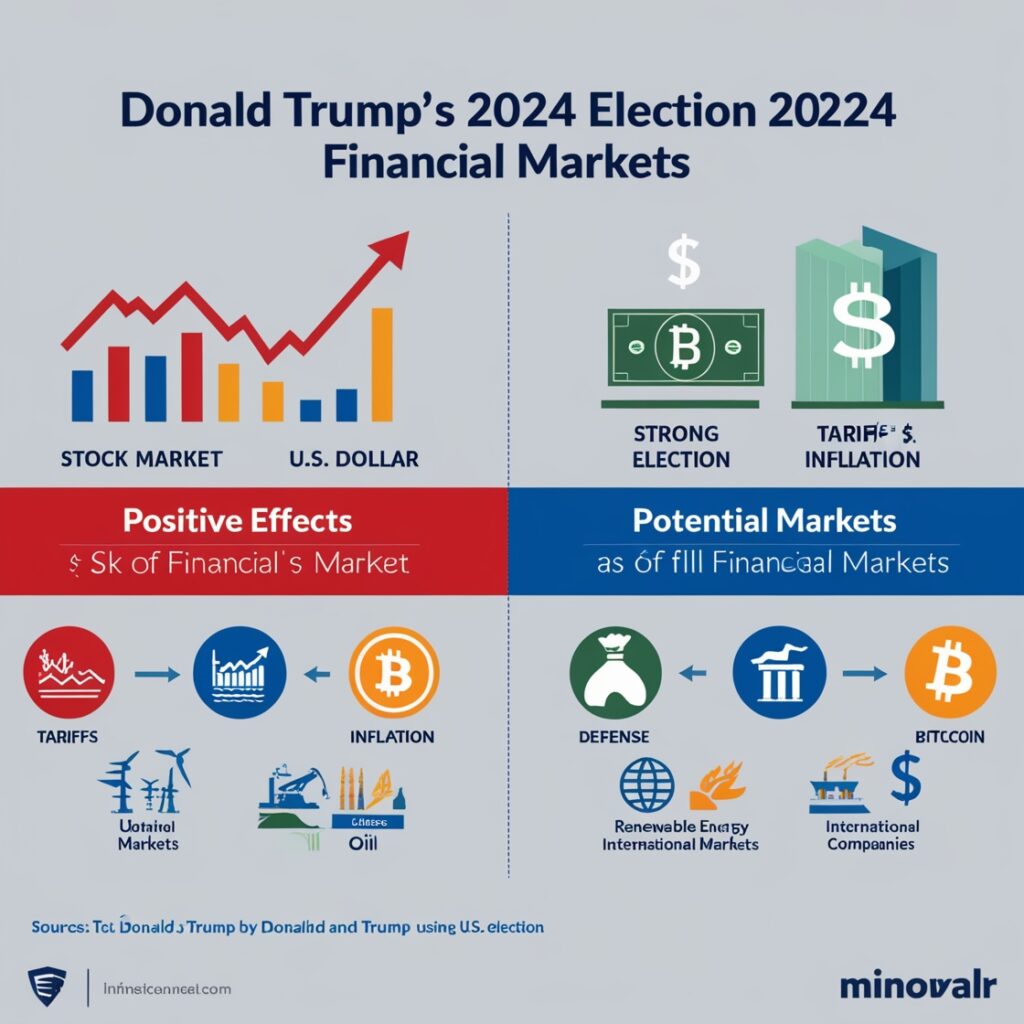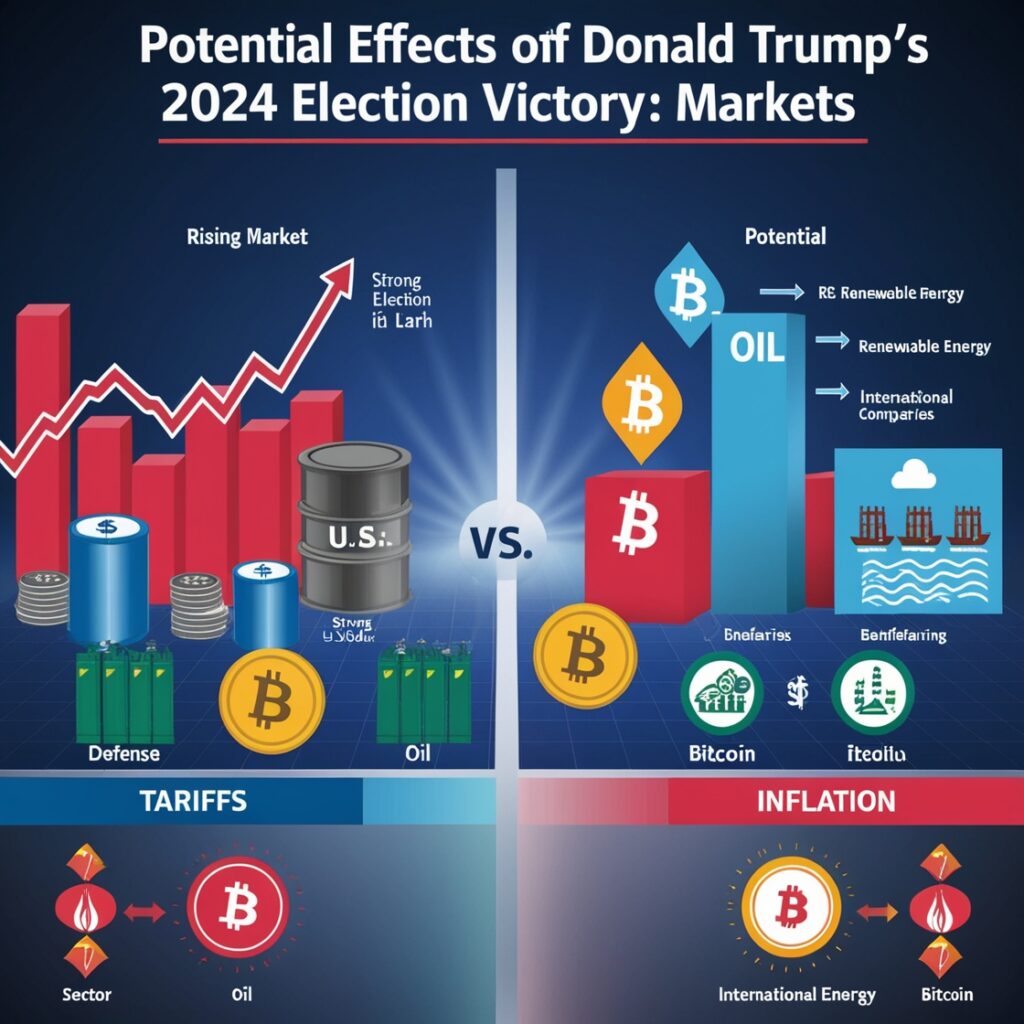Understanding the Immediate Market Reactions to Trump’s Win
Following Donald Trump’s victory in the November 2024 election, investors saw immediate impacts across global markets. According to Dan Coatsworth, an investment analyst at AJ Bell, the election boosted a variety of investments, with U.S. and European stock markets climbing, Bitcoin reaching new highs, and the U.S. dollar strengthening. However, not all sectors benefited—gold, renewable energy companies, and Chinese stocks faced immediate losses.
Key Market Movements:
- Equities: The major U.S. and European indices surged.
- Bitcoin: A new record high was achieved.
- U.S. Dollar: The dollar strengthened against other major currencies.
- Decliners: Gold, renewable energy, and Chinese shares saw downturns.
The close election outcome led many investors to delay significant moves until Trump’s victory was confirmed. Consequently, markets saw a surge in activity after the election result, though the long-term outlook remains uncertain.
Long-Term Considerations for Investors
As investors look beyond the immediate market reaction, they must weigh the potential effects of a Trump administration on various sectors and economic policies.
Economic and Tax Policy
One of Trump’s key campaign promises was to reduce corporate tax rates from 21% to 15% for companies producing domestically. This move could potentially benefit businesses by allowing them to reinvest more, buy back shares, or increase dividends. Increased post-tax earnings could drive stock prices higher, while greater corporate confidence could lead to further economic investments.
However, the situation is complex. Trump’s policy proposals may also fuel inflation. Proposed tariffs, including a 60% levy on Chinese imports and up to 20% on other international goods, could drive up costs, hurting companies unable to pass these costs onto consumers.
Potential Inflation Risks:
- Increased Import Costs: Higher tariffs on imported goods would likely push prices up, affecting both businesses and consumers.
- Labor Shortages: Trump’s strict immigration policies could create labor shortages in low-wage jobs, raising payroll expenses for many U.S. businesses.
Trump’s past term coincided with a strong stock market performance, while the Biden administration dealt with inflationary challenges and high interest rates. With Trump’s return, many voters hope for a return to lower living costs. However, inflationary risks remain, and some economic policies could complicate efforts to control price increases.

Interest Rate Implications
Investors must also consider how Trump’s policies could influence Federal Reserve decisions on interest rates. During Biden’s term, equity markets rallied, anticipating that inflation would ease and interest rates would decline. However, Trump’s inflationary policies may change this outlook.
What to Expect with Interest Rates:
- Short-Term Outlook: The Federal Reserve might still cut rates, though it may proceed with caution if inflation rises under Trump.
- Impact on Markets: A slower pace of rate cuts could create headwinds for stock markets, potentially tempering post-election gains.
Trade Policies and the Impact of Tariffs
Tariffs are a significant factor under Trump’s economic policy framework. Tariffs can harm sectors heavily dependent on imported goods or exports, particularly Chinese firms selling to the U.S. If U.S. consumers shift to American-made products due to these tariffs, international companies could see declining demand and profit margins.
Potential Trade War Risks:
- Retaliation from Affected Countries: In response to U.S. tariffs, other nations may impose their own tariffs, escalating trade tensions.
- Increased Volatility: Markets typically respond negatively to trade wars, which can create instability in global asset prices.
Sectors Benefiting Post-Election
Some sectors experienced notable gains after Trump’s victory, with a promising outlook for the near future.
Market Winners:
1. Equity Markets
- U.S. and European stock indices saw substantial gains following Trump’s election.
2. U.S. Dollar
- The dollar index rose, reflecting investor confidence in the dollar’s strength.
3. Treasury Yields
- Yields on 10-year U.S. Treasuries surged, indicating inflation expectations.
4. Defense Stocks
- Trump’s historical focus on defense spending led investors to bet on firms like BAE Systems, Northrop Grumman, and Booz Allen Hamilton.
5. Oil and Gas Stocks
- Trump’s pro-drilling stance, combined with plans for increased LNG exports, boosted U.S. oil producers like Chevron and ExxonMobil.
6. Banking Stocks
- Banks benefited from expectations of looser regulations and potentially higher interest rates under Trump’s policies.
7. Bitcoin
- Trump’s pro-crypto stance led Bitcoin to surge, with the cryptocurrency hovering around $74,230 after reaching a high of $75,281.

Stocks to Watch
Investors may find opportunities in certain stocks that align well with Trump’s policy outlook.
U.S. Stock: Citigroup
Under Trump, banks like Citigroup could face fewer regulatory constraints and potentially benefit from lower corporate taxes. With interests across retail, commercial, and investment banking, Citigroup is positioned to capitalize on increased economic activity and potentially higher interest rates, which are favorable for lenders.
UK Stock: Ashtead
Ashtead, a company specializing in equipment rental for construction and manufacturing, aligns with Trump’s vision for job growth in blue-collar sectors. Increased infrastructure projects could strengthen Ashtead’s market position and support growth, particularly as construction activity picks up in the wake of natural disaster recovery efforts.
Conclusion
Donald Trump’s 2024 election victory presents both opportunities and risks for investors. While certain sectors stand to gain from his pro-business policies and focus on domestic growth, the risk of inflation and trade conflicts could create challenges. Investors need to remain vigilant and consider the potential impact of Trump’s policies on interest rates, tariffs, and global trade dynamics as they navigate this new chapter in U.S. economic policy.



